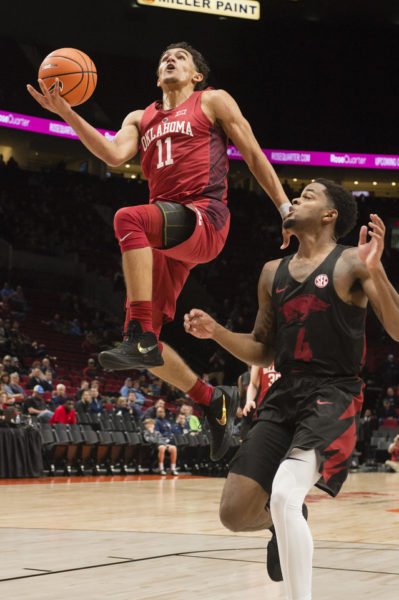Trae Young Leads Salty Sooners Back on to the National Radar
Posted by Brian Goodman on November 28th, 2017When Oklahoma lost Buddy Hield, Ryan Spangler and Isaiah Cousins after their trip to the 2016 Final Four, the Sooners predictably dropped off. They were better than their 11-20 overall record last year suggested, but you couldn’t fault anyone for tuning them out as it quickly became clear that a return to the postseason wasn’t in the cards. Just one season later, though, Lon Kruger‘s team is right back to putting up explosive numbers with one of the country’s best guards leading the way. To be clear, freshman point guard Trae Young and the former NPOY Hield are vastly different players, even aside from their different track records. Whereas Hield made most of his hay off the ball, Young is a more balanced offensive threat possessing savvy court vision to boot. In the early going, though, Young is showing that he could have a similarly memorable campaign in Norman.

After an off-year in 2016-17, Oklahoma is back among the most exciting teams in college basketball. (AP Photo/Troy Wayrynen)
Facing legitimate competition for the first time this season, Young balled out at the PK80 event in Portland, averaging 34.7 points per game across three tilts against Arkansas, Portland, and Oregon, while putting up a hyper-efficient 70.8 percent true shooting percentage. The freshman has excelled everywhere on the floor — shooting 38.6 percent from three-point range, 57.1 percent inside the arc, and 89.4 percent at the free throw line. For greater context, his 8.0 fouls drawn per 40 minutes dwarf Frank Mason’s clip of 5.5 per 40 last season, and he’s making his opponents pay at the stripe. Young’s aggression while leading the third-fastest offense in the country occasionally backfires in the form of a bad pass or ill-advised shot, but those miscues haven’t yet been detrimental to the Sooners, nor are they currently keeping him from occupying the top spot in KenPom’s National Player of the Year rankings.
The comparison to the 2016 Sooners isn’t limited to the offensive standout in the backcourt. Oklahoma’s defense operates in a similar fashion, too. It doesn’t rely on forcing turnovers, limiting three-point attempts or crashing the defensive glass (ranking outside of the top 100 in each); rather, it funnels opposing offense into the post where Khadeem Lattin, Brady Manek and Jamuni McNeace lurk to force tough attempts and block shots. Lattin and McNeace cut their teeth on that Final Four team, so it’s no surprise that that they’ve been successful in executing Kruger’s strategy by limiting the opposition to a 39.2 percent conversion rate inside the arc over the first two weeks of the season. That’s not to say that the Sooners’ defensive blueprint can’t come back to bite them, because that’s exactly what happened in last Thursday’s loss to Arkansas. The Razorbacks cashed half of their 18 three-point attempts and turned the ball over on just 18.4 percent of their 87 possessions in a 92-83 win that sent Oklahoma to the loser’s bracket.
This bend-but-don’t-break defensive approach will do the job so long as it’s coupled with effective offense, but there will be off nights. Upcoming road games against USC and Wichita State will test Oklahoma’s mettle, but the team will get a lift at semester’s end when sophomore forward Kristian Doolittle returns from academic suspension. Doolittle was the Sooners’ second-leading rebounder last year and a solid three-point shooter in a limited number of attempts, going 17-of-43 from long range. He won’t be available when they face the Trojans next Friday, but he will be for the subsequent date with the Shockers.
Oklahoma doesn’t boast an endless firing squad of three-point shooters like it did two seasons ago (at least not yet), but the Sooners are sporting a familiar look this year that not only suggests a return to the NCAA Tournament but also placement among college basketball’s most exciting watches.











































